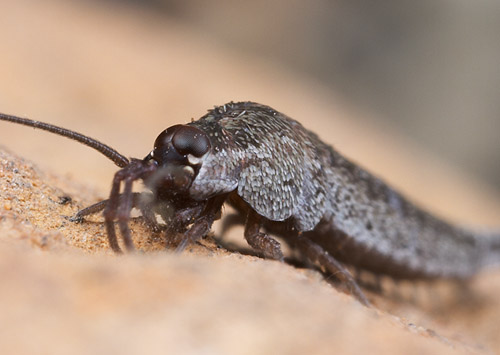Meinertellidae! It's a jumping bristletail. In California these flightless insects are common around harvester ant nests. I don't think they have any sort of specialized relationship with ants, except perhaps finding the warm microclimate of the mound surface agreeable.
Wings are an ancient adaptation, and most of our modern flightless insects represent an evolutionary loss of function from their flighted forebears. Not so with jumping bristletails. This group diverged from the remaining insects prior to the advent of wings- their line of ancestry has been earthbound since the beginning.
The multi-talented Ainsley picked the ID first, with Pete Yeeles a close second. So, 10 points, and 5 points. Or something.
- Log in to post comments
More like this
Neivamyrmex nigrescens, Arizona
Army ants have a decidedly tropical reputation. The term conjures spectacular images of swarms sweeping across remote Amazonian villages, devouring chickens, cows, and small children unlucky enough to find themselves in the path of the ants. Of course, the…
Araeoschizus sp. Ant Beetle (Tenebrionidae)
California
Araeoschizus is a small genus of darkling beetle that both resembles ants and lives close to ant nests. It occurs in the arid western regions of North America. Not much is known about the nature of the association of these beetles with the…
Mycocepurus smithi, in the fungus garden
An exciting week for ant aficionados! A new study by ant phylogenetics gurus Ted Schultz and Seán Brady provides the first detailed picture of attine evolution. These New World ants have long attracted the attention of biologists because they, like our…
Sericomyrmex ants in a laboratory fungus garden
The textbook version of the leafcutter ant and its fungus is a simple story: attine ants cultivate an edible fungus in their nests. They are obligate farmers, eating only the fungus, and the fungus is a specialized cultivar found only in ant nests…


Alex, I would like to redeem my points for a nice close-up photo of the next leiodid you run across. Or more staphylinoids in general!
Sounds like a deal! I don't run into Leiodids very often, though. Is there a fail-safe Leiodid-hunting trick?